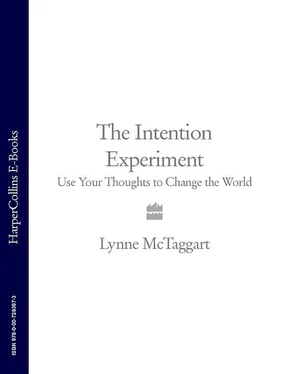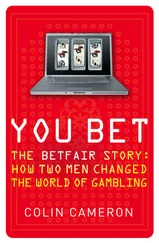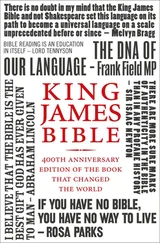1 ...7 8 9 11 12 13 ...25 Although modern physicists now accept non-locality as a given feature of the quantum world, they console themselves by maintaining that this strange, counter-intuitive property of the subatomic universe does not apply to anything bigger than a photon or electron. Once things got to the level of atoms and molecules, which in the world of physics is considered ‘macroscopic’, or large, the universe started behaving itself again, according to predictable, measurable, Newtonian laws.
With one tiny thumbnail’s worth of crystal, Rosenbaum and his graduate student demolished that delineation. They had demonstrated that big things like atoms were non-locally connected, even in matter so large you could hold it in your hand. Never before had quantum non-locality been demonstrated on such a scale. Although the specimen had been only a tiny chip of salt, to the subatomic particle, it was a palatial country mansion, housing a billion billion (1,000,000,000,000,000,000 or 10 18) atoms. Rosenbaum, ordinarily loathe to speculate about what he could not yet explain, realized that they had uncovered something extraordinary about the nature of the universe. And I realized they had discovered a mechanism for intention: they had demonstrated that atoms, the essential constituents of matter, could be affected by non-local influence. Large things like crystals were not playing by the grand rules of the game, but by the anarchic rules of the quantum world, maintaining invisible connections without obvious cause.
In 2002, after Sai wrote up their findings, Rosenbaum polished up the wording and sent off their paper to Nature , a journal notorious for conservatism and exacting peer review. After four months of responding to the suggestions of reviewers, Ghosh finally got her paper published in the world’s premier scientific journal, a laudatory feat for a 26-year-old graduate student. 10
One of the reviewers, Vlatko Vedral, noted the experiment with a mix of interest and frustration. 11A Yugoslav who had studied at Imperial College, London, during his country’s civil war and subsequent collapse, Vedral had distinguished himself in his adopted country and been chosen to head up quantum information science at the University of Leeds. Vedral, who was tall and leonine, was part of a small group in Vienna working on frontier quantum physics, including entanglement.
Vedral first theoretically predicted the effect that Ghosh and Rosenbaum eventually found three years later. He had submitted the paper to Nature in 2001, but the journal, which preferred experiment to theory, had rejected it. Eventually, Vedral managed to publish his paper in Physical Review Letters , the premier physics journal. 12After Nature decided to publish Ghosh’s study, its editors threw him a conciliatory bone. They allowed him to be a reviewer on the paper, and then offered him a place in the same issue to write an opinion piece on the findings.
In the article, Vedral allowed himself some speculation. Quantum physics is accepted as the most accurate means of describing how atoms combine to form molecules, he wrote, and since molecular relationship is the basis of all chemistry, and chemistry is the basis of biology, the magic of entanglement could well be the key to life itself. 13
Vedral and a number of others in his circle did not believe that this effect was unique to holmium. The central problem in uncovering entanglement is the primitive state of our technology; isolating and observing this effect is only possible at the moment by slowing atoms down so much in such cold conditions that they are hardly moving. Nevertheless, a number of physicists had observed entanglement in matter at 200 K, or –73°C – a temperature that can be found on Earth in some of its very coldest places.
Other researchers have proved mathematically that everywhere, even inside of our own bodies, atoms and molecules are engaged in an instantaneous and ceaseless passing back and forth of information. Thomas Durt of Vrije University in Brussels demonstrated through elegant mathematical formulations that almost all quantum interactions produce entanglement, no matter what the internal or surrounding conditions. Even photons, the tiniest particles of light emanating from stars, are entangled with every atom they meet on their way to earth. 14Entanglement at normal temperatures appears to be a natural condition of the universe, even in our bodies. Every interaction between every electron inside of us creates entanglement. According to Benni Reznik, a theoretical physicist at Tel Aviv University in Israel, even the empty space around us is heaving with entangled particles. 15
The English mathematician Paul Dirac, an architect of quantum field theory, first postulated that there is no such thing as nothingness, or empty space. Even if you tipped all matter and energy out of the universe and examined all the ‘empty’ space between the stars you would discover a netherworld world teeming with subatomic activity.
In the world of classical physics, a field is a region of influence, in which two or more points are connected by a force, like gravity or electromagnetism. However, in the world of the quantum particle, fields are created by exchanges of energy. According to Heisenberg’s uncertainty principle, one reason that quantum particles are ultimately unknowable is because their energy is always being redistributed in a dynamic pattern. Although often rendered as tiny billiard balls, subatomic particles more closely resemble little packets of vibrating waves, passing energy back and forth as if in an endless game of basketball. All elementary particles interact with each other by exchanging energy through what are considered temporary or ‘virtual’ quantum particles. These are believed to appear out of nowhere, combining and annihilating each other in less than an instant, causing random fluctuations of energy without any apparent cause. Virtual particles, or negative energy states, do not take physical form, so we cannot actually observe them. Even ‘real’ particles are nothing more than a little knot of energy, which briefly emerge and disappear back into the underlying energy field.
These back-and-forth passes, which rise to an extraordinarily large ground state of energy, are known collectively as the Zero Point Field. The field is called ‘zero point’ because even at temperatures of absolute zero, when all matter theoretically should stop moving, these tiny fluctuations are still detectable. Even at the coldest place in the universe, subatomic matter never comes to rest, but carries on this little energy tango. 16
The energy generated by every one of these exchanges between particles is unimaginably tiny – about half a photon’s worth. However, if all exchanges between all subatomic particles in the universe were to be added up, it would produce an inexhaustible supply of energy of unfathomable proportions, exceeding all energy in matter by a factor of 10 40, or 1 followed by 40 zeros. 17Richard Feynman himself once remarked that the energy in a cubic metre of space was enough to boil all the oceans of the world. 18
After the discoveries of Heisenberg about Zero Point energy, most conventional physicists have subtracted the figures symbolizing Zero Point energy from their equations. They assumed that, because the Zero Point Field was ever present in matter, it did not change anything and so could be safely ‘renormalized’ away. However, in 1973, when trying to work out an alternative to fossil fuel during the petrol crisis, American physicist Hal Puthoff, inspired by the Russian Andrei Sakharov, began trying to figure out how to harness the teeming energy of empty space for transport on earth and to distant galaxies. Puthoff spent more than 30 years examining the Zero Point Field. With some colleagues, he had proved that this constant energy exchange of all subatomic matter with the Zero Point Field accounts for the stability of the hydrogen atom, and, by implication, the stability of all matter. 19Remove the Zero Point Field and all matter would collapse in on itself. He also demonstrated that Zero Point energy is responsible for two basic properties of mass: inertia and gravity. 20Puthoff also worked on a multimillion-dollar project funded by Lockheed Martin and a variety of American universities, to develop Zero Point energy for space travel – a programme that finally went public in 2006.
Читать дальше











